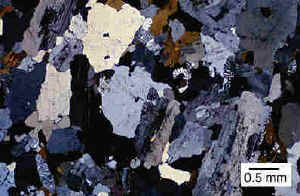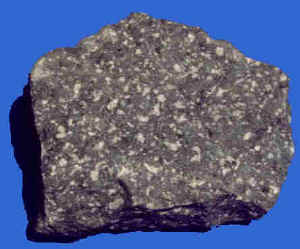|
However, what do you do if the rock is aphanitic and
you canít see the minerals? In this case, you can use color as a
guide. Rhyolites are usually light colored, ranging from white to pink
to light gray. In contrast, basalts are dark colored, usually dark green
to black. Andesites are in between, for example gray as opposed to white
or black.
A more precise method is to make a thin section of
rock and count the minerals in a given space and then calculate
percentages. You can use this method for both aphanitic and phaneritic
rocks.
There are many other types of igneous rocks caused
by many different situations. The cooling rate can create bizarre
looking rocks. Some rocks start cooling inside and then are
"coughed" up. The rock will have a background (matrix) of fine
grained volcanic rocks with larger crystals that were cooling slowly.
This texture is called porphyritic.
|

Thin section of granite

Porphyritic andesite
|